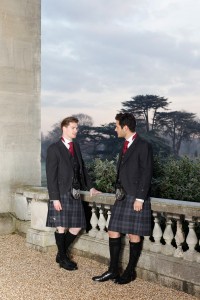Following news that tradition of Scottish Highland wear is continuing to transcend the border and grow in popularity all around the UK, the experts at Young’s Hire are here to give you a brief insight into the tartan classic.
When it comes to special occasions and getting formal, traditional highland wear has always been seen as a statement of true Scottish identity. However, with the style being as popular as ever, Young’s Hire, the UK’s largest independent men’s formalwear supplier examines the Scottish style.

The staple item when it comes to showing formal Highland style is the kilt. Having been around since the 16th century, it’s hardly a new style to rock at weddings, formal dinners and special occasions. However, whilst the novelty might wear off with some trends, this iconic piece of Scottish style has truly stood the test of time. When it comes to Highland wear, it’s as much a social occasion as a photo opportunity, and as is always going to be the case with clothing that has stood the test of time, the kilt, or those who design it, are constantly coming up with new ways to update and modernise the iconic formal look.
When it comes to colours and styles, it’s no surprise that the traditional look is successful, with styles such as grey granite and pride of Scotland check proving hugely popular. Despite this, modernisations on the classic look do prove to be successful, with more contemporary patterns, such as Young’s Help for Heroes tartan proving that the tradition can work with a contemporary twist.
With pairing, it’s all about staying classic and traditional. Due to the lack of pockets in a kilt, the sporran – a pouch that performs the same function is an absolute must, whilst kilt hose (long socks) and a sgian-dubh (a small, single edged knife generally tucked into the right sock) are often traditional. On the upper body, it’s standard to opt for a kilt jacket, which has a slightly higher fit than a standard jacket, whilst a standard white shirt is also paired with neckwear.
The popularity of tartan, kilts and highland wear in general is no longer simply a Scottish look, as the style now spreads throughout the UK and worldwide. When it comes to England rivalling the Highlands, cities including London, Leicester, Manchester, Sheffield Liverpool, Bristol, Newcastle and Cardiff all rank highly on a new study into the popularity of Scottish formalwear.
It’s always fascinating to take a more holistic look at the formalwear trends around the UK, and it's great to see that although people are really broadening their horizons when it comes to suiting-up for a special occasion, the traditional items like a top hat and tailcoat are still proving very popular but it’s great that traditional Scottish highland wear is also still going strong at weddings.


Add new comment